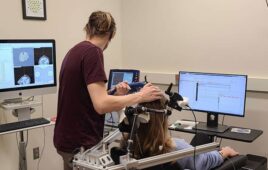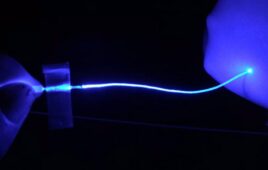
Luis Gomez, Electrical Engineering Ph.D. Student, goes over brain simulation results from headpiece that consists of a square array of 64 circular metallic coils. (Credit: Joseph Xu, Michigan Engineering Communications & Marketing)

In transcranial magnetic stimulation, special coils create a fluctuating magnetic field that then generates a weak electrical field that can travel through the scalp and skull noninvasively. The electrical signal activates neurons in targeted parts of the brain—a complex electrical network itself. (Credit: Joseph Xu, Michigan Engineering Communications & Marketing)

The headpiece design is a big departure from today’s figure 8-shaped devices made of just two coils. The researchers knew that in order to send a sharper signal, they’d have to change the shape of the fluctuating magnetic field the coils produce. (Credit: Joseph Xu, Michigan Engineering Communications & Marketing)
Read: How a Metamaterial Might Improve a Depression Treatment




